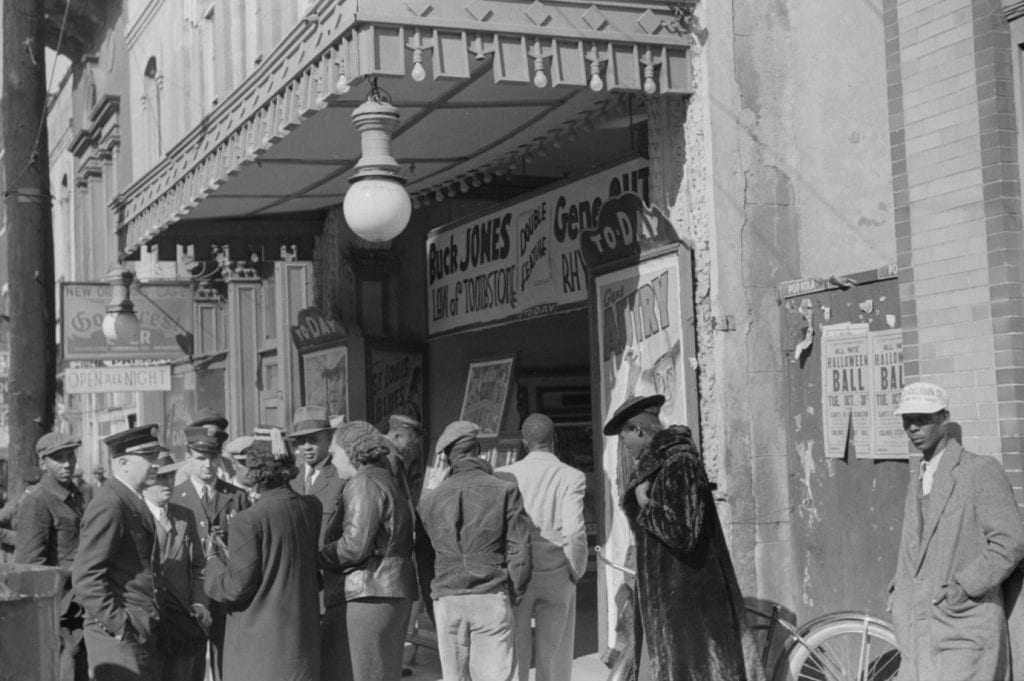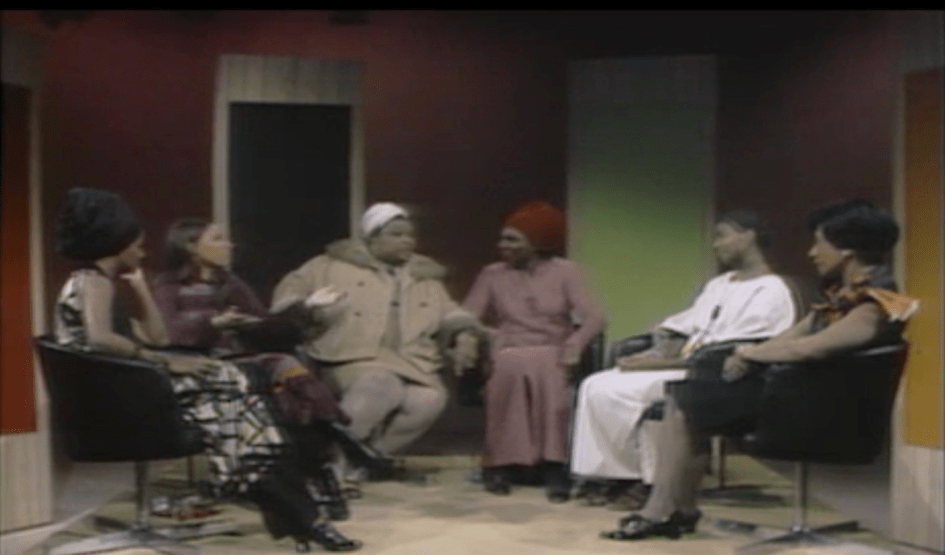by Manar Ellethy
“I’m inspired by mostly women. Maybe because of my grandmother, and my mother, and the women in my life. Who is that said, ‘I’ve known rivers,’ well, I’ve known women?”
In the summer of 1968, Amina Baraka, a poet, artist, activist, and community organizer in Newark, New Jersey, joined forces with her husband, Amiri Baraka, to create a short documentary film titled The New Ark. While The New Ark ostensibly presents a patriarchal narrative, a closer look reveals a story of Black nationalist women working hard to break that narrative from within. Doing so required these women to re-explore questions concerning their selfhoods and how they were defined, both individually and collectively. Such re-exploration meant using their everyday experiences as Black women and as daughters, wives, workers, activists, artists, organizers, mothers, and/or intellectuals to create a radical, self-defined space of womanhood.
The New Ark represents one of the few examples of Black women’s engagement with documentary film and television as part of a larger effort to employ these mediums in the United States in the 1960s. Reflecting the decade’s monumental socio-political struggles, documentary film became an arena in which fights for Black dignity and liberation took place; creating what can be defined as a Black documentary renaissance. Prior and parallel to the women of The New Ark, countless other women engaged with documentary film and television for that radical purpose, fighting for themselves and their communities. Doing so required these women to believe in other women and the subversive power of art and culture. Black nationalist women, who themselves had their internal disagreements, were thus part of a larger diverse and multifaceted collectiveness in which Black women radically defined and expressed their womanhood on- and off-screen. Above all, Black women’s on and off-screen expressions of radical womanhood exemplify the process of finding oneself, not autonomously, but as reflected in the radical lives of others and, primarily, other Black women.

In a 1970 episode titled “The Black Woman” aired on Black Journal—a program on the educational broadcast network National Educational Television (NET) dedicated to covering issues relevant to Black communities—several Black women gather around the table to discuss the questions facing them. Among the women were the journalist and “Positively Black” hostess Joan Harris, the culinary anthropologist Vertamae Grosvenor, the NAACP lawyer Jean Fairfax, the community organizer Martha Davis, the television producer Marion Etoile Watson, and Amina Baraka. All these women had different stories, backgrounds, ages, and experiences. They came from various organizations and communities—some were Black nationalists, others were not, some called themselves feminists, others did not. Yet, each in their own way, represented the spirit of radical womanhood’s “shadowboxing.” The women, aware of the shadowing and silencing imposed on their womanhood, were “fighters who battle as outsiders,” fighting publicly and privately against their vilification, marginalization, confinement, and structures of inequality. (82) The Black Journal Executive Producer, Toni Brown, opens the episode by stressing that this “group was brought together with as many differences as likenesses but held together by the common thread of the black experience,” that they “speak about survival if you are born a woman and black in this society […] as a unique institution the black woman remains.” The group’s segment encapsulates the broader diversity within unity of Black radical womanhood and the importance of self-definition.
Throughout their discussion, the women disagree with each other, especially on the specific methods, tactics, and priorities guiding their work. They do, however, acknowledge each other’s needs and agree on the principles of their fight, occasionally nodding and smiling at each other, reaffirming each other’s words and feelings. Nothing is more unanimously stressed than the importance of the self and defining the self, the inevitability of disagreement within unity, and the need for structural change by working collectively, either within or outside the system. This is mostly stressed by Amina Baraka. Maria Watson tells the group, “We should be about redefinition,” and Baraka continues, “If we go about being the inspiration of the nation […] we create a new life, a new value system […] you get yourself together first, then you get your community together […] I mean black people’s lives, being self-determining, defining yourself, naming yourself, and having political power […] it’s always a self-thing.” The women nod in agreement while Joan Harris lowers her head in tears, moved by Baraka’s words. Revisiting the issue of internal disagreements, Watson asks Baraka, “what about the sisters who don’t agree?” to which Baraka responds, “it’s not about agreeing with me, it’s about doing. […] nobody wants to be a slave and there is no black person on this planet who would disagree with freedom.” The women pause, meeting each other’s gazes as they smile in agreement, to which Fairfax adds, “many people will be working on things from different perspectives, working on the problems of freedom in different ways.”
This televised discussion showcases the active political, cultural, and intellectual contributions and ideas of Black women active in the documentary film and television spheres. Above all, it illustrates the importance of cultural production and expression to these women. It stands as an exemplar of what Ashley D. Farmer describes as the “multifaceted and long-standing conversation” among Black women activists of the era regarding how to assert radical womanhood. (3) Early in the discussion, Joan Harris emphasizes the role of media and cultural production, stating: “Unfortunately all people in this country, black people and white people, are subjugated to the same system of media, are subjugated to same systems of communication […] that’s something we definitely have to reckon with if we’re ever going to get through any of this stuff.” Reckoning thus meant understanding the detrimental roles of media and cultural production and transforming those mediums into liberatory platforms Black women could identify with. Three of the six women in the group were actively involved in this sphere, working as television producers or on independent community film projects. Not only were the women aware of the power of cultural production, but they were also actively engaged with it as a political institution and vehicle for radical structural change. Cultural production represented a collective space for a radically articulated and self-defined womanhood. When exposing their own private experiences in front of the camera, listening, and speaking to each other, expressing themselves culturally and politically, they publicly laid bare their radical womanhood onscreen. They are “shadowboxing” on and off the screen— “privately they box with themselves, their kin” and, publicly, they box collectively against structures of oppression and inequality, in the process inspiring, mobilizing, and revolutionizing. (176)

The 1960s ushered in a cultural movement in which Black women continued to use film as a tool that merges the cultural and political. Articulating their struggles, Black women throughout the 1960s used the power of the camera in numerous ways, following in the footsteps of their “cinematic foremothers” such as Zora Neale Hurston and Eloyse King Patrick Gist and countless other Black women who engaged with the medium of documentary film in their own ways. Madeline Anderson, who grew up in a low-income family in the largely segregated town of Lancaster, Pennsylvania, had always seen the connection between film and Black struggles. She later recounted how “the films we saw didn’t reflect who we were. Even then I wanted to see us in film” (280), recalling in another interview that “I really wanted to be a filmmaker. Of course, everybody ridiculed that idea. A poor, Black female? You could never be a filmmaker. But I never gave up on my dreams.” She took whatever film jobs she could find and later became part of NET’s Black Journal, first as an editor and then as a producer, working alongside the pioneering Black documentary-maker William Greaves and other Black women, including Sheila Smith Hobson and Hazel W. Bright. During her time at Black Journal, she made A Tribute to Malcolm X (1967), a documentary based mainly on her interviews with X’s wife, Dr. Betty Shabazz. With her promotion to the position of producer, Anderson became the program’s first Black woman producer. One of her biggest struggles was getting into the film union as a Black woman. In an interview, she explains: “You probably can’t imagine the disrespect I experienced as a black woman trying to get into a predominantly white male union and without the normal connections.” (76) By the time Anderson embarked on her documentary concerning a Black hospital workers’ strike I Am Somebody in 1969, Anderson had finally become part of the film union. Her work continued to inspire other Black women filmmakers such as Julie Dash and Ava DuVernay.
Women like Marian Etoile Watson, Sheila Smith Hobson, Peggy Pinn, and Hazel W. Bright also found their way into television and filmmaking. Watson worked for WNEW/Channel 5 as an associate producer for the series Inside Bedford Stuyvesant (1968). Hobson also worked at Black Journal. Hobson struggled to get into television in New York, hearing “nothing for black women […] do you see any other black women around? Any black anything?” in response to her numerous job applications. She finally landed a job at NET’s Black Journal as a researcher. (71-73) While at Black Journal, Smith Hobson also worked with filmmaker Peggy Pinn. Pinn was the project coordinator at the program’s workshop, which trained Black filmmakers, producers, and other minority group students to work on Black Journal documentaries and reporting. Pinn later became an associate producer at Black Journal in 1969. In an interview with Black Enterprise magazine in 1971, Pinn reflected on her time at the workshop and how hard it was for her to manage it as a woman: “Men have a difficult time taking women seriously in this business.” She told the magazine that there were a number of times “when I was so disheartened that I seriously considered throwing up my hands and finding some man to run the program” but in the end, she was determined to break that cycle. (37-38)
Many of the abovementioned women crossed paths during their careers; some worked together, some learned from each other, and some had their disagreements. Although they approached the medium in different ways, they radically fought for themselves while exploring their own womanhood amid a structure that continuously refused to give them seats at the table. Black women found their way into this scene throughout the 1960s in diverse ways. Some women, including Amina Baraka, did so independently, while others, including Fannie Lou Hamer, participated in documentary film projects as part of their organizations and communities, or simply by agreeing to voice their feelings and plights in interviews. Many of these women participated in films that sometimes leaned towards patriarchal and masculinist normative understandings of the civil rights struggle in which Black women are, as Jaqueline Najuma Stewart argues, “seen but not heard. Admired visually, but on the sidelines of the central topic.” (161) This, however, does not take away from the agency and intent–either known or unknown to us–of the women engaged with films. As Audre Lorde reminds us in Sister Outsider, because of their Blackness, “Black women have on the one hand always been highly visible, and so, on the other hand, have been rendered invisible through the depersonalization of racism. […] visibility which makes us most vulnerable, is also the source of our greatest strength.” (42-44) Being rendered as the peripheral “Other,” Black women seized the opportunity offered by the camera to reclaim that vulnerability and express themselves. They pushed the limits by engaging with documentary films as an artistic reflection of their lives, fighting to define themselves. As Lorde argues, this “self-determination” is “the decision to define ourselves, name ourselves, and speak for ourselves, instead of being defined and spoken for by others.” (42-44) With that, they sought to break the silences imposed on their womanhood that fed off their fears, doubts, and exhaustions. Doing so was and remains hard work.

Manar Ellethy is a PhD Candidate at the Roosevelt Institute for American Studies and Leiden University in the Netherlands. Her research focuses on Black visual culture and culture resistance in the 1960s, particularly via the medium of documentary film.
Edited by Thomas Cryer
Featured Image: A still from “The Black Woman,” Black Journal, Episode 28, produced by National Educational Television and Radio Center, December 28, 1970. Courtesy of the Library of Congress, American Archive of Public Broadcasting, July 5, 2023.



